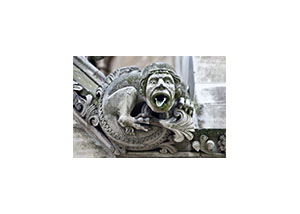Imagine. It is the year 1440. You are standing on a quiet hillside somewhere deep in the heart of France. Off in the distance, you see the double-spired magnificence of a Gothic cathedral, its newly quarried stone gleaming white against a backdrop of green trees and azure sky. Almost at once, the sound of the bells reaches your ears, inviting you to draw closer.
After countless footsteps, you arrive at last at the cathedral’s great western door. Now, however, the view is not quite so appealing. Above the entrance, a zealous artist has carved out a scene of the Last Judgment in graphic detail. The expression of bliss is unmistakable on the faces of the elect. They have just heard Our Lord pronounce His most glorious invitation: “Enter into the Kingdom prepared for you from the foundation of the world.” Yet on the Master’s left, there is a sea of anguished horror, portrayed with all the skill and faith of a sculptor who, doubtless, knew well the meaning of despair. The Judge’s sentence is almost audible: “Depart from me, you cursed, into the eternal fire prepared for the devil and his angels.” The very stones seem to cry out in torment.
Overhead loom the hideous gargoyles, clever drain spouts designed literally to scare the hell out of potential pilgrims. Each gargoyle is unimaginably grotesque. One demonic figure dines with sadistic glee on some mangled human appendage. Another holds a pair of scales with which to weigh the souls of the damned so as to assign them their proper place in Hades. A third monster has just flung an unrepentant sinner into the fires of perdition.
Despite the hellish façade, you reach out to grasp the iron ring on the massive wooden door. You pull. The hinges groan in protest. The door gives way. You slip inside.
As your vision grows accustomed to the cathedral’s dim interior, you are suddenly overcome by the sweet fragrance of incense and the faint aroma of beeswax. Echoes of Gregorian chant add to the realization that you have entered another world. Now your eyes can make out your surroundings. The high pointed arches draw your gaze upward from the colorful tiled floor to the rich Venetian velvets and damasks suspended over the nave. Higher still, you observe the vaulted ceilings adorned with delicate golden foliage and stars. Most breathtaking of all, however, are the great expanses of stained glass, providing an almost unearthly illumination. Particularly stunning is the beautiful rose window over the high altar, the crowning glory of the entire edifice. Here the Virgin and Saint Anne are presented in subtle hues and astounding intricacy. You discover that you are in a haven that is both warm and personal. You are experiencing a symphony of light and, as one author aptly puts it, “a riot of color and gilding.” Almost without effort, the psalmist’s praises flood your memory: “How lovely is your dwelling place, O Lord of hosts! ….For one day within your courts is better than a thousand elsewhere.”
From a distance, the imposing structure of a Gothic cathedral may appear mysterious and beckoning. Yet at the threshold, it often wears the face of judgment. Those brave enough to enter find a world very much like heaven itself. The best way to see a great cathedral is from the inside.
The Roman Catholic Church is, for better or worse, very much like a Gothic cathedral. When seen at a distance, she beckons us and bids us draw near. As we approach her, she often frowns on us with the stern face of judgment, and it is then that we notice the “gargoyles.” Yet if we are courageous enough to penetrate her austere façade, we will surely discover a warm and colorful sanctuary within, the home for which we have always yearned.
If, at this moment, you find yourself smarting under the Church’s judgment and condemnation because of something you have done, if you have been hurt or frightened by a gargoyle or two, do not turn away. Remember how far you have already traveled. You feel the way you do, not because you are far away from the Church, but precisely because you are so very near. Gargoyles are frightening only when seen at close range. Your journey, then, is almost over. You are standing on the very threshold of peace itself! Take courage. Do not run from Christ the Judge. Look the gargoyles straight in the face. Enter through the western door. Make your way through the nave and go right into the chancel. Lay your heart upon the high altar and there offer it to Jesus.
Just as in the Mass, bread and wine are transformed into the Body and Blood of Christ Himself, so will your heart undergo a kind of transubstantiation and be changed into His heart. Then pain will be turned into peace, and peace will be transformed into joy.
The best way to see the Roman Catholic Church is from the inside. All it takes is a bit of courage.

